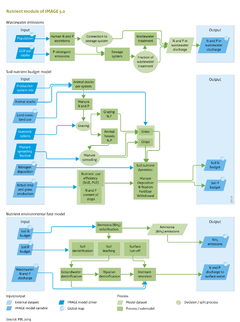Nutrients/Policy issues: Difference between revisions
Jump to navigation
Jump to search
LexBouwman (talk | contribs) No edit summary |
No edit summary |
||
| (16 intermediate revisions by 3 users not shown) | |||
| Line 1: | Line 1: | ||
{{ComponentPolicyIssueTemplate | {{ComponentPolicyIssueTemplate | ||
|Description=Under | |Description=Under baseline scenarios of IMAGE-GNM, N surpluses generally increase. For example, in the Rio+20 baseline scenario, the N surplus increases by 35% globally in the period 2002-2050 (the figure below). This is the result of decreasing trends in North America, Western Europe and Japan as a result of increasing nutrient use efficiency, and stabilisation in India. In all other regions, N surpluses increase, particularly in Sub-Saharan Africa and Southeastern Asia as a result of increasing fertilizer use to halt soil nutrient depletion (the figure below). The situation is similar for P, with large increases in developing countries. | ||
Economic developments and policy interventions may modify individual terms in the soil nutrient budget ( | No scenarios have been implemented yet with the full IMAGE-GNM. However, results for the 20th century show that the global river N export (19 to 37 Tg/yr, or +90%) increased faster than P export (2 to 4 Tg/yr or +75%). The increase in export by rivers draining into the Pacific Ocean (3.7 to 14.7 Tg N/yr, increase by a factor of 4; 0.6 to 1.6 Tg P per year, factor of 1.5) and Mediterranean Sea and Black Sea (0.9 to 2.1 Tg N/yr, +126%; 0.2 to 0.4 Tg P yr/yr, +80% ) was much faster than in other parts of the world (the figure below). The increase in P export was smaller than that of N in world regions. The differential increase of N and P explains the increase in the N:P ratio in rivers draining into the Pacific Ocean (13 to 20), Indian Ocean (14 to 18 since 1970), Mediterranean Sea and Black Sea (10 to 13). There was no clear increase in the regions draining into the Atlantic Ocean. | ||
|Example=Economic developments and policy interventions may modify individual terms in the soil nutrient budget (Formula 1, [[Nutrients/Description|Model description part]]), and the fate of nutrients in the environment. For example, agricultural demand (Component [[Agricultural economy]]) affects: | |||
* production of leguminous crops (pulses and soybeans) and biological N fixation as a consequence; | |||
* meat and milk production and thus animal manure production; | |||
* crop production and fertiliser use. | |||
The IMAGE soil nutrient model includes options to reduce nutrient surpluses in agriculture or nutrients in wastewater, and strategies to improve resource use efficiency. Wastewater strategies that can be assessed with tools available in the nutrient model of IMAGE include: | The IMAGE soil nutrient model includes options to reduce nutrient surpluses in agriculture or nutrients in wastewater, and strategies to improve resource use efficiency. Wastewater strategies that can be assessed with tools available in the nutrient model of IMAGE include: | ||
* Increasing access to improved sanitation and connection to sewerage systems; | |||
* Construction of wastewater treatment plants; | |||
* Substituting synthetic fertilisers with fertilisers produced from human excreta. This option has no consequences for nutrient budgets, but reduces wastewater flows. | |||
IMAGE also addresses strategies for reducing nutrient surpluses in agriculture, including the five options illustrated in the figure below: | |||
* Extensification (EX), assuming for example that 10% of ruminant production in mixed and industrial systems shifts to pastoral production systems. | |||
* Increased feed conversion efficiency (FE), assuming for example 10% reduction in N and P excretion for cattle, pigs, poultry and small ruminants in mixed and industrial systems. This is achieved by increasing the use of concentrates. | |||
* Improved manure storage systems (ST), considering for example 20% lower NH<sub>3</sub> emissions from animal housing and storage systems. This means that the animal manure used for spreading contains 5% more N than under the baseline scenario. | |||
* Integrated manure management (IM) where, for example, all manure under the baseline scenario ends up outside the agricultural system (e.g., manure used as fuel, see the figure above) and is recycled in crop systems to substitute fertiliser. In addition, integration of animal manure in crop systems is improved, particularly in industrialised countries. | |||
* Dietary changes (DI), for example, assume that by 2050, 10% of beef consumption under the baseline scenarios is replaced by poultry meat in all producing regions, without accounting for changes in agricultural trade. | |||
Extensification, increased feed efficiency and reduced ammonia emissions from stables (cases EX, FE and ST) have minor effects on the global soil N budget (the figure below). However, better integration of animal manure in crop production systems (IM), primarily in industrialised countries, and a change in the human diet with poultry replacing ruminant meat (DI) would have major effects on the global soil N budget. | |||
Other options that can be assessed using scenario variables from other parts of IMAGE include: | Other options that can be assessed using scenario variables from other parts of IMAGE include: | ||
* Consequences of changes in crop production systems, such as increasing crop yields, that would improve fertiliser use efficiency; | |||
* Consequences of changes in livestock production systems such as better management leading to lower excretion rates; | |||
* Changes in the distribution of total production between mixed and pastoral systems; | |||
* Changing human diets leading to changing production volumes. | |||
See also Policy interventions Table below | |||
}} | }} | ||
Revision as of 12:49, 4 November 2016
Parts of Nutrients/Policy issues
| Component is implemented in: |
| Components: |
| Related IMAGE components |
| Projects/Applications |
| Key publications |
